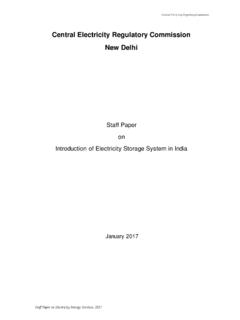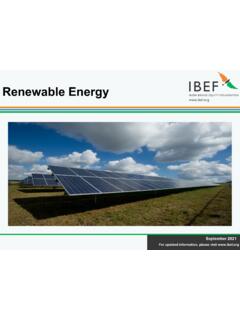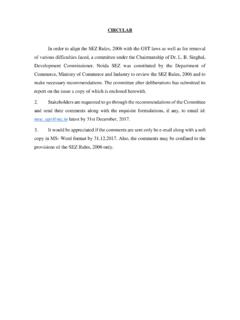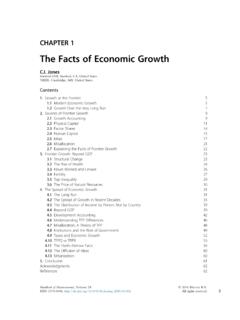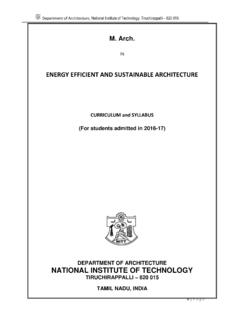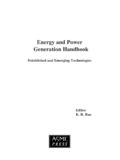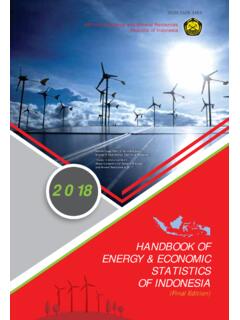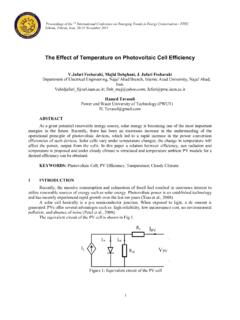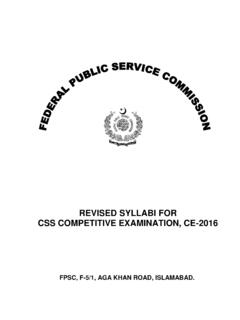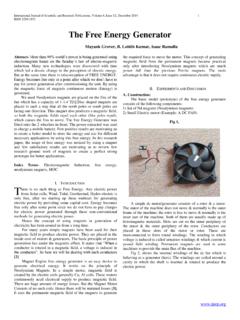Transcription of PERFORMANCE OF SOLAR POWER PLANTS
1 February, 2011 PERFORMANCE OF SOLAR POWER PLANTS IN india Submitted To Central Electricity Regulatory Commission New Delhi 2 Table of Contents List of figures .. 3 List of tables .. ii .. 6 Jawaharlal Nehru National SOLAR Mission (JNNSM) .. 6 Energy 7 Role of Central and State Governments .. 7 Objectives of the report .. 7 Methodology .. 8 Technology for SOLAR POWER PLANTS .. 9 SOLAR Photovoltaic (PV) technologies .. 9 SOLAR Thermal(CSP) technology .. 10 PERFORMANCE of SOLAR POWER PLANTS .. 12 Radiation .. 13 SOLAR radiation basics and definition .. 15 Measurement of SOLAR radiation .. 15 Sources of SOLAR radiation data .. 16 Losses in PV SOLAR systems .. 19 SOLAR Plant design .. 21 Long term reliability .. 24 Module Degradation.
2 25 Background .. 25 Causes of degradation .. 26 Case studies on degradation .. 29 Estimation of CUF for SOLAR POWER PLANTS .. 33 PERFORMANCE of Operational SOLAR POWER PLANTS .. 38 Conclusions and recommendations .. 41 References .. 42 3 List of figures Figure 1: SOLAR Thermal Technologies.. 11 Figure 2: SOLAR energy fundamentals and modelling techniques: atmosphere, environment, climate change and renewable energy .. 14 Figure 3: List of radiation stations installed by IMD. Source: IMD website.. 16 Figure 4: SOLAR radiation zones as per TERI based on IMD database.. 19 Figure 5: MPPT Maximum POWER point tracking.. 21 Figure 6: SOLAR Module charactersics at different Insolation level .. 22 Figure 7: Degradation data .. 31 Table 8:Module Figure 7: Radiation at different tilt angles.
3 23 Figure 8: Temerature coefficient for crystalline SOLAR cells .. 24 4 List of tables Table 1: Commercial efficiencies of photovoltaic modules .. 9 Table 2: Radiation data sources .. 17 Table 3: Global adiation at optimum tilt .. 23 Table 4: Guarantees by various suppliers .. 27 Table 5: POWER degradation .. 29 Table: 6 NREL degradation study .. 30 Table: 7 Module Reliability .. 33 Table: 8 Crystalline silicon modules .. 35 Table: 9 CUF of different locations .. 36 Table: 10 CUF of Chandrapur POWER plant.. 39 Table: 11 Monthly POWER generation.. 40 Table: 12 Actual POWER generation at Plant commissioned by POWER in Table: 13 Actual POWER generation at 3 MW Kolar and Belgaum PLANTS .. 41 5 Introduction There is a pressing need to accelerate the development of advanced clean energy technologies in order to address the global challenges of energy security, climate change and sustainable development.
4 SOLAR Photovoltaic is a key technology option to realize the shift to a decarbonised energy supply and is projected to emerge as an attractive alternate electricity source in the future. Globally, the SOLAR PV grid connected capacity has increased from GW in 2007 to GW in 2008 and was 21 GW at the end of 2009. Similarly, annual SOLAR PV production also jumped from GW in 2007 to GW in 20091. The growth trend is continuing and is likely to explode once the grid parity is achieved. india is located in the equatorial sun belt of the earth, thereby receiving abundant radiant energy from the sun. The india Meteorological Department (IMD) maintains a nationwide network of radiation stations which measure SOLAR radiation and also the daily duration of sunshine. In most parts of india , clear sunny weather is experienced 250 to 300 days a year.
5 The annual global radiation varies from 1600 to 2200 which is comparable with radiation received in the tropical and sub-tropical regions. The equivalent energy potential is about 6,000 million GWh of energy per year. The highest annual global radiation is received in Rajasthan and northern Gujarat. In Rajasthan, large areas of land are barren and sparsely populated, making these areas suitable as locations for large central POWER stations based on SOLAR energy. The Indian government has launched Jawaharlal Nehru National SOLAR Mission (JNNSM) with a target of achieving 20000 MW by 2022. The goal is to make india one of the leaders in SOLAR energy. Although SOLAR energy is still expensive today, but costs are coming down with technology development, right governmental policies and R and D efforts.
6 Jawaharlal Nehru National SOLAR Mission (JNNSM) The mission will be carried out in three phases and aims to do the following: to create a policy framework for deployment of 20,000 MW by 2022; to add 1,000 MW of grid SOLAR POWER by 2013, and another 3,000 MW by 2017. The target for 2017 may be higher based on the availability of international finance and technology transfer. The scheme also aims at strengthening indigenous manufacturing capability, and achieving 15 million sq. meters SOLAR thermal collector area by 2017 and 20 million by 2022. One of the steps to achieve this will be to make SOLAR heaters mandatory by incorporating byelaws in the National Building Code. Deployment of 20 million SOLAR lighting systems for rural areas by 2022 is also part of the scheme.
7 1 Renewables 2010, Global Status Report, REN21. 6 This mission has received widespread support from agencies like the World Bank and the Clinton Initiative. Also, the launch of organisations like the SOLAR Thermal Federation of india (STFI) indicates that the industry is gearing up for a shift towards SOLAR . Energy Security india needs to focus on developing its own sources of energy. Our major energy sources, oil and coal, are imported in large quantities. Even with the development of nuclear energy, india will be dependent on other nations for fuel. To sustain economic growth, to come out of the energy deficit situation and ensure that energy is available in every town and village, india must utilise its immense potential in SOLAR energy.
8 Role of Central and State Governments india is the only country with a Ministry dedicated to New and Renewable Energy. There are nodal agencies in each State, which specifically work on enhancing the percentage of renewable energy in the POWER -mix. States such as Rajasthan, Karnataka, Maharashtra, Gujarat, and West Bengal have already taken initiatives for installation of large SOLAR POWER PLANTS . The MNRE also announced Generation Based Incentives (GBI) in 2008, to incentivize development of SOLAR POWER PLANTS . Objectives of this report It is clear from the above discussion that SOLAR energy is becoming an important source of energy all over the World and especially in india . Very few SOLAR PLANTS have been installed in india so far, and therefore no historical experience available.
9 It is important to investigate the PERFORMANCE of SOLAR POWER PLANTS . Knowledge about the PERFORMANCE of SOLAR POWER PLANTS will result in correct investment decisions, a better regulatory framework and favorable government policies. In this report, we examine the various factors contributing to the PERFORMANCE of SOLAR POWER PLANTS , such as radiation, temperature and other climatic conditions, design, inverter efficiency and degradation due to aging. The objectives of this study are summarized below: To estimate the PERFORMANCE of SOLAR POWER PLANTS at different locations in the country To assess the degradation of module output associated with aging as per current technology trends To recommend future work in the field of SOLAR energy To review existing radiation data sources and softwares To review design criteria for better PERFORMANCE of POWER PLANTS Methodology For this report, information and data from a wide variety of sources has been used, which includes theoretical knowledge of SOLAR energy technology, for both SOLAR PV and SOLAR thermal POWER PLANTS , available in standard literature.
10 Data for SOLAR radiation has been analysed from sources such as the handbook of SOLAR Radiation for india (Anna Mani, Allied Publishers) india Meteorological Department (IMD), National Aeronautics and Space Administration (NASA), National Renewable Energy Laboratory (NREL), Ministry of New and Renewable Energy (MNRE) and Meteonorm. Software analysis It has been found that data from the above sources varies over a wide range, depending on whether it is collected from monitoring stations, extrapolated, or derived from satellite information. Data from the above mentioned sources is analysed using software such as PVSyst and RETS creen. This facilitates easy comparison of irradiation levels from different sources, and POWER output from SOLAR PLANTS , with variation in type and make of panel used, the angle of tilt of the panel, the use of tracking mechanism, local weather conditions such as temperature, and losses such as panel degradation, inverter losses and so on.
